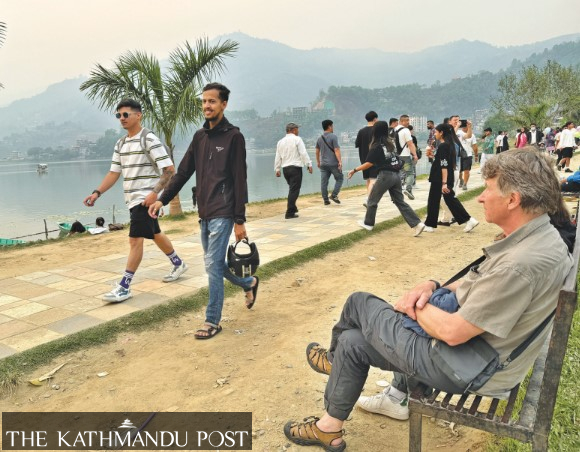French couple Pascal Blanc and Susan Blanc are currently visiting Pokhara for a sightseeing tour.
The couple was inspired to visit Pokhara after reading the book “Annapurna” by French mountaineer Maurice Herzog, leader of the 1950 French Annapurna Expedition.
Herzog’s first ascent of the 8,091-meter-high Annapurna I in June 1950 put Pokhara on the world map and established it as the gateway to the Annapurna region, a trekker’s paradise.
In the 1970s and late 1980s, Pokhara remained a favorite destination for Western hippies.
On Tuesday, The Post caught up with the couple as they visited the tranquil Lake Fewa.
“The sky is hazy. I don’t think you can see Mount Annapurna from here,” said Pascal, 71.
They plan to trek the Ghodepani-Poon Hill route, a year-round short trek that is suitable for everyone, with beautiful views of Annapurna.
“Next week our dream will come true. We hope there will be no pollution in the mountains,” said Susan, 74.
Pokhara offers stunning views of the three 8,000 Mountains: Annapurna I, Dhaulagiri and Manaslu. Similarly, Mount Machhapuchhre also attracts both domestic and international tourists.
People taking pictures with Machhapuchhre in the background is a common sight in Pokhara.
But experts say the situation could change if pollution is not tackled.
Now, even in spring, Pokhara is shrouded in thick fog. Locals say the sky in Pokhara has been covered in dust and fog since March. The air is not healthy. I can’t even see the mountains.
Dar Bahadur Shrestha from Sankamur in Kathmandu and his family of six arrived on Tuesday at Phumdi Bhumdi, a small village in the hills of Pokhara.
But they couldn’t see the mountains. Phewa Lake and Pokhara Bazaar were also shrouded in fog.
“Unlike my previous holidays, I couldn’t enjoy myself this time,” said Shrestha, who is coming to Pokhara for the fifth time. “It’s sad that you can’t see the mountains from Pokhara. The sky is cloudy here.”
Recently declared as the tourist capital of Nepal, Pokhara was an exceptional city with no air pollution until a few years ago.
Currently, the bowl-sized city is shrouded in smog and fog during spring, one of the country’s peak tourist seasons. Flights may be canceled or delayed due to poor visibility due to fog.
Despite the current eye-popping smog levels, entrepreneurs in the travel industry are bracing for bad weather ahead in the popular tourist destination.
Pokhara, located in the central region of Nepal, is the second most popular tourist destination in the country after the capital Kathmandu.
Ananda Gurung, president of Pokhara City Tour Guide Association, said, “When the sky is covered with thick smog, foreign tourists become reluctant to take sightseeing tours.” She said: “Contamination can quickly emerge as a major problem.”
“Tourists are starting to shorten their stay,” Gurung said.
Pokhara Tourism Council Chairman Pomnarayan Shrestha said the pollution could seriously impact Pokhara’s burgeoning tourism industry if the government did not act in time.
There are ripple effects of smog pollution in other villages of Kaski as well.
Situated northeast of Pokhara, Sikruz village was once a popular hill station for tourists admiring the Annapurna range. However, the area is also covered in pollution.
Paras Gurung, chairman of the Sickles Hotel Management Committee, said the spread of wildfires was worsening the situation.
It is said that a wildfire recently spread in the forest near Taprang.
Tourists often ask if they can see the mountains from Sickles. “We cannot lie to our guests. But if the situation does not improve, we stand to lose everything. Many reservations have been cancelled.”
Mr. Gurung said tourists in Sikurus have started shortening their stays due to pollution.
“We have had forest fires in the past, but they were short-lived. In the last couple of years, smog has started to come out of the forests and stay in the sky for longer before rain comes,” Gurung said. .
Smog has spread from Pokhara to Annapurna region. According to trekking guide Hira Mala, the mountain cannot be seen from Ghandruk, a popular tourist spot.
Mara said she was hired by two foreigners for a 14-day trek from Mardi, Ghandruk, Ghorepani to Poon Hill to Kopra, but requested the itinerary be shortened as the skies were covered in fog. .
“Then I returned to Pokhara on the 11th day.”
Air quality in Pokhara reached “unhealthy” levels on Monday, with an AQI reading of 164, according to IQAir, an international company that monitors air pollution.
It was 152 on Tuesday.
Flight operations were suspended at Pokhara International Airport for several hours due to poor visibility due to pollution.
Sustainable development activist Hum Bahadur Gurung said that apart from wildfires, pollution transmitted from miles away from India often causes fog in Pokhara.
“Mountain villages are also being affected. The impact could be disastrous for rural economies dependent on tourism,” Gurung said.
If air pollution reduces the number of tourists, hotels and homestays will receive less revenue, he said.
According to the forest department in Pokhara, wildfires have spread over 5,000 hectares of forest since February. Additionally, most farmers in the southern Terai plains light farm fires before planting maize.
Experts say farmers in Nepal have also turned to fire to burn plants due to a lack of manpower to collect straw. In the past few years, the majority of farmers did not burn the plants, preferring to treat the straw in other ways as feed for livestock.
Kaski Forest Department Director Komal Raj Kafle said local communities have a major role to play in minimizing forest fires. “We need to create awareness among people not to set fire in forests. The forest ministry needs to come up with a detailed plan to create awareness,” he said.

